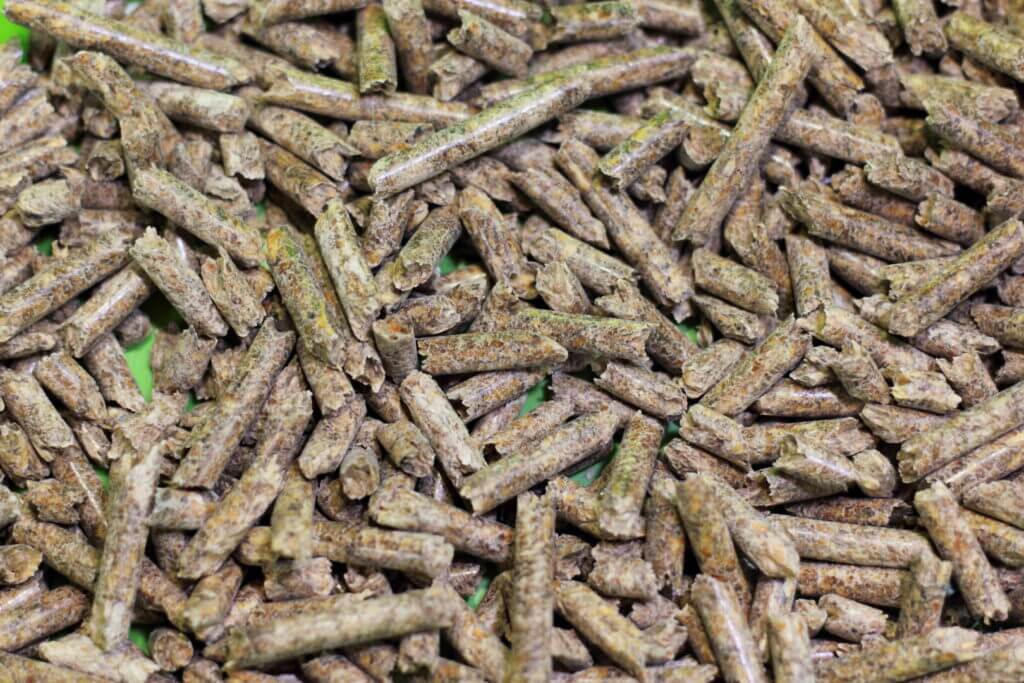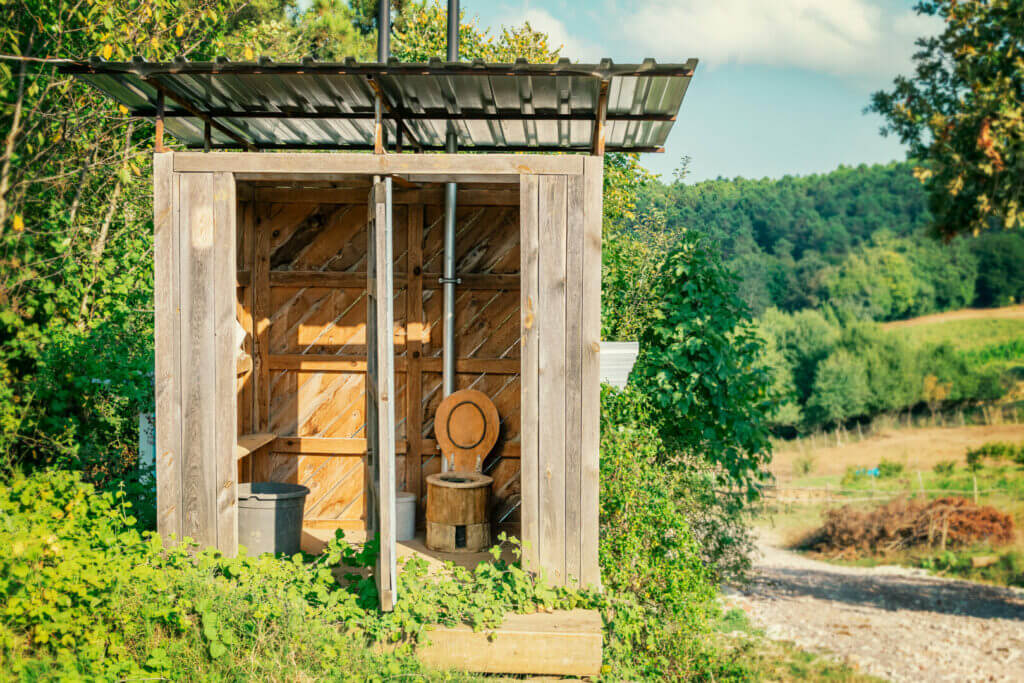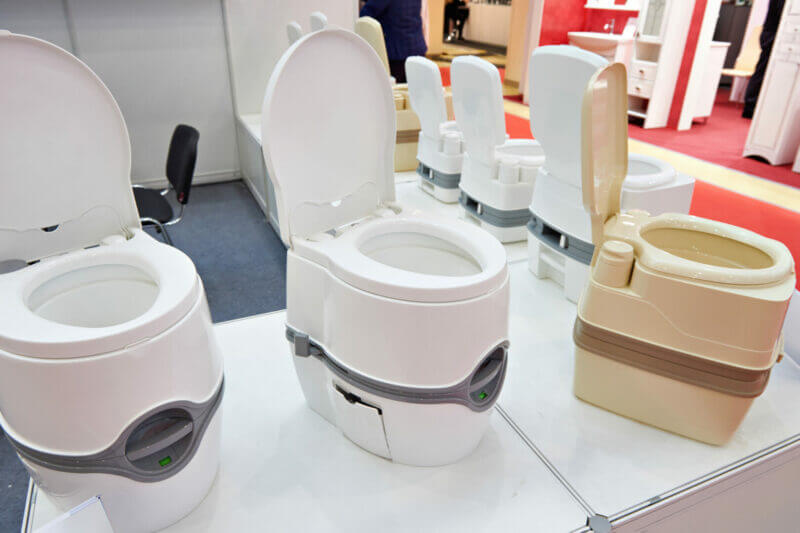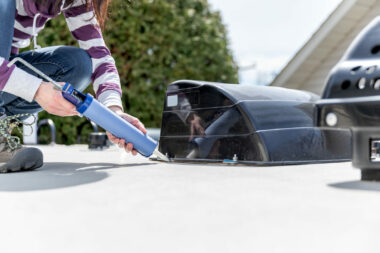Table of Contents Show
Almost every RVer dreads the black water tank! It’s something we are frequently asked about by newbies or folks considering the RV lifestyle. Let’s face it, it’s the dirtiest job when it comes to RVing and not many look forward to it. You can remove this dirty task by considering a composting toilet for an RV.
However, when you bring up RV composting toilets, people seem pretty split. If you don’t have one, you’ve probably heard the myths about them. Today, we’re going to debunk myths around composting toilets for RVs and recommend the best one!
What Is a Composting Toilet for Your RV?
A composting toilet for RVs is an alternative to the black tank. It breaks down human waste naturally by mixing organic material (like peat) into it. The composting process turns into fertilizer and can be disposed of almost anywhere, unlike the waste created from an RV black tank. Pretty cool, huh?
How Do RV Composting Toilets Work?
When you go to the bathroom, the commode separates liquid and solid waste and diverts each to its separate tank. You flush with no water. As a result, solid waste doesn’t turn into sewage, and it usually reduces odors in between tank emptying.
To help facilitate solid waste breakdown, you’ll add an organic material of some sort when you flush. Peat is the typical go-to. Solid waste will dry up more quickly with this addition, and it also helps speed up decomposition. Some composting toilets for your RV have a crank to stir the mixture.
After a few weeks, your solid waste will have turned to compost. Then, you just dump the bin into a trash bag or a composting bin.
Liquid waste requires more frequent dumping. Usually, you need to empty the tank every 1-2 days, depending on how much you use it. You can dilute the urine and dump it on the ground in some places. Just remember to steer clear of water sources, other campsites, and so on, and watch for posted guidelines for the area. And remember, never dump the solid compost on the ground.

Myth 1: A Composting Toilet For an RV Smells Bad
As we mentioned before, composting toilets are virtually odorless. It’s a welcome change from the usual RV bathroom situation. Since no liquids mix with your solid waste, you probably won’t notice a smell.
Additionally, some RV composting toilets have an air-tight seal on the lid to trap any would-be smelly air. The few times we have heard from friends of their composting toilet smelling, it’s usually due to accidentally getting some liquid into the solids tank. So just be sure to adequately empty your urine tank when needed.
Myth 2: RV Composting Toilets Are For Hippies
Composting toilets in an RV are great for anyone! If you like to spend time off-grid instead of a traditional RV park, you need a composting toilet. It will make your life so much simpler and less smelly.
By installing a composting toilet, you are significantly cutting back on your water usage as well. Not only will you no longer have to flush your toilet, but if you’ve ever had to flush and clean a black tank, you know how much water that can take. Sure, this is an environmentally friendly reason to have a composting toilet in your RV, but who doesn’t love that?

Myth 3: RV Composting Toilets Are Gross
Let’s be honest, waste in any form is gross. Because you handle your waste a little more intimately with a composting toilet for your RV, they have a reputation of being gross.
Most RVers who have a composting toilet say it’s no worse than dumping your black tank. In fact, some RVers say their composting toilet is less messy since they don’t have to deal with smell or accidental sewer spills.
Myth 4: You Can’t Use Toilet Paper In A Composting Toilet For Your RV
You may have heard that you can’t use toilet paper with RV composting toilets. While some composting toilet owners may not dispose of their toilet paper in the toilet, others do. There’s no rule saying composting toilets can’t handle toilet paper.
Some RVers opt to use a separate trash can for their toilet paper for one reason. Adding toilet paper to the waste chamber will cause it to fill up faster. If you do want to dispose of toilet paper in your RV composting toilet, we recommend using one-ply.
Pro Tip: If you’re still using an RV black tank, the toilet paper you use matters. Check out the Best RV Toilet Paper for Your Holding Tank.
Myth 5: It’s Hard To Install an RV Composting Toilet
Most RVers install their own composting toilet. The actual installation process is quite simple and usually only involves a few screws. However, you will have to ensure the ventilation hose has an external outlet. This can prove to be the trickiest part for some RVers.
Benefits of Using a Composting Toilet in Your RV
There are several reasons to use a composting toilet for your RV. First, composting toilets are ideal for boondocking. Boondocking means you don’t have hookups, so you have to be careful about water usage and tank space.
But with a composting toilet, you reduce both. You can turn your black water tank into extra grey water holding area. You also won’t be flushing fresh water down the drain. Both things mean you can stay off-grid for longer!
Something else simply extraordinary is the lack of odor. Blackwater tanks can get smelly, but a composting toilet is virtually odorless if you take care of it properly.
If this all sounds great, the last perk of a composting toilet is easy installation. Since you don’t have to hook up to your black or grey tanks, the process is straightforward. If you live in an RV, chances are you’re handy enough to figure this one out!
Pro Tip: You don’t need to use expensive RV toilet paper. Check out these RV Toilet Paper Alternatives You’ll Wish You Used Sooner.
Things to Consider When Choosing An RV Composting Toilet
If you think a composting toilet might be right for you, how do you decide what to get? There are lots of privies on the market, but not all are equal. Here are some things to consider when making your choice.
Size
One primary consideration is size. RV bathrooms are notoriously small, so you need a lavatory that will fit in the space. You’ll want a tape measure for this one.
Price
Consider the price as well. A composting toilet for an RV will not come cheap, but there’s a whole range of prices. Consider your budget before buying, but also realize you may get what you pay for. Not to mention, when you’re talking about containing human waste, cheaper isn’t always better.
Reviews
Finally, before you buy anything for our RV, toilet included, read reviews. Every product nowadays has online reviews. Read what actual customers have to say about it; this will help you find a quality product.
The Best Composting Toilet for Your RV
- No one - and I mean no one - will beat my customer service and individual support
- Easy to install by any reasonably handy person.
Nature’s Head is hands down the best composting toilet for RVs. While the price tag might be a shock at first, it’s reasonably priced for a composting toilet, coming in just under $1,000.
This toilet comes with a solid crank to help waste decompose more quickly. You can install the crank on whichever side you want, and since space is so limited in RV bathrooms, the versatility is exceptional!
Two people can use the Nature’s Head composting toilet full-time and expect to empty the solid tank every four to six weeks. You need to dump the liquid tank every one to two days, which is pretty standard for a composting toilet.
Lastly, the toilet only weighs 28 pounds, making installation and emptying the solid waste chamber a breeze.
Debunk Those RV Composting Toilet Myths
A composting toilet for RVs is a fabulous and simple way to upgrade your rig. You’ll love all the things you no longer have to smell, and if you’re a regular boondocker, a composting toilet will change your life. We love ours and hope you’ll love yours too.
Last update on 2025-01-19 / Affiliate links / Images from Amazon Product Advertising API








On our first trip we had the black tank fall out on the highway, after cutting it clear from the rig and strapping up the underbelly we kept going, ordered the natures head and we are liking it a lot more.
I’m full time and my Natureshead solids need to be emptied weekly, with just one average adult and one toddler using it. Urine tank even more often. I’ve read the owner info and tons of other websites, so yes I’m using it correctly. It also does have a smell, mostly from the urine container which is difficult to clean.
To have the grey water fill into the black, do you do some plumbing or just open both slide valves from time to time?
A little extra plumbing would be your best bet.